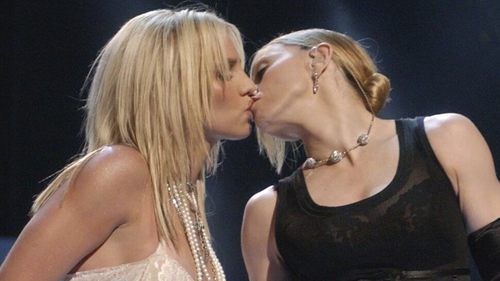


By Lance Welton
05/11/2019

Lesbianism, or at least being “queer,” is currently fashionable among celebrity females. Madonna, Britney Spears and Ariana Grande all use “hints” of — non-exclusive — lesbianism to “titillate” their fans.(Madonna and Britney are pictured above at the 2003 MTV Music Awards. ) The wannabe-edgy Miley Cyrus, who is married to a man, has referred to herself as “queer” because she’s had lesbian experiences and feelings. Lesbian feminist Julie Bindel regards this as complete nonsense, insisting that “real lesbians commit to the role”. [Why are boringly straight women claiming to be lesbians?, Spectator USA, May 2, 2019] However, the remarkable fact is that society may have evolved in a way that really is creating more real lesbians.
Fascinatingly, lesbianism is not simply the female version of being a homosexual male. It just doesn’t follow the same rules.
Evolutionary psychologists have various theories as to how male homosexuality might have evolved — it was useful to the group to have a caste of non-breeding males or it reduces inter-male conflict [Homosexuality, birth order, and evolution, by Edward Miller, Archives of Sexual Behavior, 2000], or it might even be an in utero disease. But they can’t explain lesbianism.
Fortunately, a group of leading evolutionary psychologists have now given it their best shot, with an eye-opening review of the evolution of what Miley Cyrus claims, in part, to be.
The journal Evolutionary Psychological Science will soon publish “The Evolution of Human Female Sexual Orientation” by Austin Jeffrey and his team, based at Oakland University in Rochester, Michigan. [PDF, in press]. This article is based on its findings,
The Jeffrey et al. study begins by highlighting just how different female homosexuality is from that of males. Male sexual orientation is about 40% genetic, whereas with females it is only 20% caused by genes, meaning it’s overwhelmingly the result of environmental factors. This implies that evolution has selected for a portion of exclusive homosexuals among males, making male sexuality more genetic, but for sexual fluidity among females.
In other words, it is optimally useful for societal survival to have a caste of definite gay men and a caste of sexually fluid women.
Roughly 3 per cent of Americans say they are “homosexual” but 20% of US females claim to have had feelings of same-sex attraction or lesbian experiences. Usually males who had have homosexual experiences are exclusively homosexual and identify as such. But equivalent females will identify as “bi” or “queer,” with only a minority claiming to be “lesbian.” In males, heterosexual attraction strongly negatively correlates with homosexual attraction, but in females the relationship is weak. Males, note the authors, regard only nude females as “sexual,” whereas females see all nudes as “sexual.”

Lesbianism is not some “modern” perversion. It can be observed in societies under Darwinian conditions. In Ancient China, some women would become the concubines of high status wives. In Nigerian and Kenyan tribes, single mothers get together with “butch” females who act as their de facto husbands. If you go to Lesotho, you will find that there are lesbian relationships between older women and pubescent girls. Lesbianism is also widespread among various apes, who will masturbate each other with their hand-like feet.
“What is going on?” ask the authors, reasonably.
Firstly, they distinguish between two kinds of lesbian: “butches” and “femmes.” “Butches” are masculinized females: masculinized to the extent that they are attracted exclusively to other females. These out-and-out lesbians have high levels of circulating testosterone as well as other masculine traits, such as a low “2D:4D” ratio (meaning their fingers are all of a relatively similar lengths) and left-handedness (also higher among males).
Often, the mothers of “butches” have suffered from adrenal hyperplasia, meaning that butches are exposed to too much testosterone while in the womb. More often than not, butches are attracted to “femmes” — feminine, bisexual or experimenting females — and vice versa.
But how can this kind of behavior have been selected for anyway, when 90% of heterosexual women have children compared to only 30% of bisexuals or lesbians?
The authors explore all of the possibilities. Lesbianism could be a by-product of something adaptive: two copies of an allele and you’re prone to lesbianism; one copy and you’re extremely fertile, so lesbianism stays in the population. It’s like sickle cell anemia. One copy of the allele and you are immune to malaria; two copies and you have the disease. So sickle cell anemia stays in the population because of the siblings of sufferers are going to raise more children, because they’re immune to malaria, compared to the general population.
The problem: there is evidence that sisters of homosexual males have elevated fertility, but here’s no evidence for this among the siblings of lesbians.
Some researchers have proposed that males find lesbianism attractive and so lesbianism stays in the population because men are turned-on by fantasizing about two females having sex.
However, to the extent that this is true, it would be the “femmes” that they would be aroused by. But there is no hard evidence that men are likely to try to seduce females who are bisexual over heterosexual.
Yet another possibility: males are attracted to some masculine qualities in women — such as bravery and drive — which means that, just by chance, in some females, these all coalesce together.
But even if this is true, it doesn’t explain why female sexuality is so environmentally fluid, but male sexuality is not
A better explanation, argue the Jeffrey team: so-called “self-dominance” models.
Most human social organizations are polygamous. This happens because females are selected to be attracted to the highest status males because these are the most likely to be able to look after them and their offspring, elevating the likelihood of survival. This creates a situation where lots of co-wives have to be able to get along and to form alliances to receive the most investment in their children, as the alpha male’s attention turns to younger, more fertile wives. This would select for these females being able to work together to “alloparent” — to help each other raise each other’s children.
Of course, alloparenting would be easier if there were no feelings of aggression or jealousy between these women. And this would, in turn, be easier if they could create intensely strong bonds with each other, leading to a de facto nuclear family, via sexual attraction.
In particular, it would mean that the co-wives would be less jealous of the younger or more attractive co-wives who were receiving more attention from the male, which would help to create a more harmonious society.

Consistent with this model, females are very strongly prone to become gay in the absence of high-status males. In all-female prisons, note the authors, about 60% of inmates reporting being “lesbians” — in other words, prison makes them homosexual.
The alloparenting hypothesis has some amazing implications for a society based around “female equality.”
Females, but not males, generally sexually select hypergamously (upwards) in terms of status. In other words, they are programed to want a sexual partner who has higher socioeconomic status than they do.
But, as British educationalist Joanna Williams has explored in depth in her 2017 book Women Vs. Feminism: Why We All Need Liberating from the Gender Wars, males and females now have at least equal socioeconomic status. And in many Western countries young females are more educated than males of the same age. (Itself a subject worthy of another column).
This would mean that more and more females, especially highly educated and intelligent ones, find it very difficult to locate a higher status male.
In the absence of such males, we would expect them to turn to lesbianism — pairing up with the highly genetically homosexual “butches,” for example.
So maybe Miley Cyrus’s bisexuality is more than just a publicity stunt. As an extremely rich and successful female, there are probably very few males she’ll actually find attractive.
Perhaps she doesn’t even find her husband particularly attractive. And maybe that leads to her eventually developing genuine homosexual feelings.
Lance Welton is the pen name of a freelance journalist living in New York.